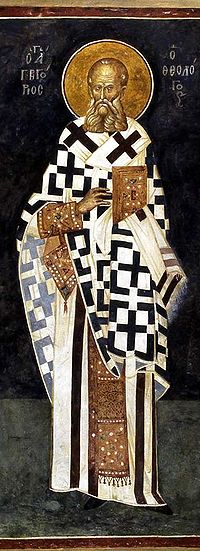Gregory the Theologian, also known as Gregory of Nazianzus (though that name more appropriately refers to his father) and Gregory the Younger, was a great Father and Teacher of the Church.
With Sts. Basil the Great and John Chrysostom, he is numbered among the Three Holy Hierarchs whose feast day is celebrated on January 30. St. Gregory is also known as one of the Cappadocian Fathers.
He was born in 329 in Arianzus, a village of the second district of Cappadocia, not far from Nazianzus. His father, who later became Bishop of Nazianzus, was named Gregory (commemorated Jan. 1), and his mother was named Nonna (Aug. 5); both are among the saints, and so are his brother Caesarius (Mar. 9) and his sister Gorgonia (Feb. 23).
At first he studied in Caesarea of Palestine, then in Alexandria, and finally in Athens. As he was sailing from Alexandria to Athens, a violent sea storm put in peril not only his life but also his salvation, since he had not yet been baptized. With tears and fervour he besought God to spare him, vowing to dedicate his whole self to Him, and the tempest gave way to calm.
At Athens Saint Gregory was later joined by St. Basil the Great. Another fellow student of theirs in Athens was the young Prince Julian, who later as Emperor was called the Apostate because he denied Christ and did all in his power to restore paganism. Even in Athens, before Julian had thrown off the mask of piety; St. Gregory saw what an unsettled mind he had, and said, "What an evil the Roman State is nourishing" (Orat. V, 24, PG 35:693).
After their studies at Athens, Gregory became Basil's fellow ascetic, living the monastic life together with him for a time in the hermitages of Pontus. His father ordained him presbyter of the Church of Nazianzus.
About the year 379, Saint Gregory came to the assistance of the Church of Constantinople, which had already been troubled for forty years by the Arians; by his supremely wise words and many labours he freed it from the corruption of heresy, and was elected Archbishop of that city by the Second Ecumenical Council, which assembled there in 381, and condemned Macedonius, Archbishop of Constantinople, as the enemy of the Holy Spirit.
When St. Gregory came to Constantinople, the Arians had taken all the churches and he was forced to serve in a house chapel dedicated to St. Anastasia the Martyr. From there he began to preach his famous five sermons on the Trinity, called the Triadica.
When he left Constantinople two years later, the Arians did not have one church left to them in the city.
St. Gregory the Theologian. Image source: Wikipedia, public domain.
Having governed the Church until 382, he delivered his farewell speech—the Syntacterion, in which he demonstrated the Divinity of the Son—before 150 bishops and the Emperor Theodosius the Great; in this speech he requested, and received from all, permission to retire from the see of Constantinople. He returned to Nazianzus, where he lived to the end of his life, and reposed in the Lord in 391, having lived some sixty-two years.
His extant writings, both prose and poems in every type of metre, demonstrate his lofty eloquence and his wondrous breadth of learning. In the beauty of his writings, he is considered to have surpassed the Greek writers of antiquity, and because of his God-inspired theological thought, he received the surname "Theologian."
Although he is sometimes called Gregory of Nazianzus, this title belongs properly to his father; he himself is known by the Church only as Gregory the Theologian. He is especially called "Trinitarian Theologian," since in virtually every homily he refers to the Trinity.
He is widely considered the most accomplished rhetorical stylist of the patristic age. As a classically trained speaker and philosopher he infused Hellenism into the early church, establishing the paradigm of Byzantine theologians and church officials.
A Byzantine-style icon depicting the Three Holy Hierarchs: (left to right:) Basil the Great, John Chrysostom and Gregory the Theologian. Image source: Wikipedia, public domain.
References:
Gregory the Theologian - OrthodoxWiki
Gregory of Nazianzus - Wikipedia, the free encyclopedia
GOARCH.org.
Related:
Subscribe to:
Post Comments (Atom)


No comments:
Post a Comment